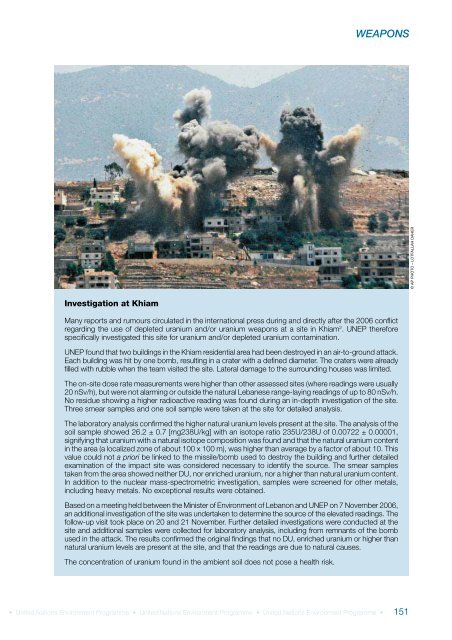Lebanon Post-Conflict Environmental Assessment - UNEP
Lebanon Post-Conflict Environmental Assessment - UNEP
Lebanon Post-Conflict Environmental Assessment - UNEP
You also want an ePaper? Increase the reach of your titles
YUMPU automatically turns print PDFs into web optimized ePapers that Google loves.
WEAPONS© AP PHOTO – LOTFALLAH DAHERInvestigation at KhiamMany reports and rumours circulated in the international press during and directly after the 2006 conflictregarding the use of depleted uranium and/or uranium weapons at a site in Khiam 2 . <strong>UNEP</strong> thereforespecifically investigated this site for uranium and/or depleted uranium contamination.<strong>UNEP</strong> found that two buildings in the Khiam residential area had been destroyed in an air-to-ground attack.Each building was hit by one bomb, resulting in a crater with a defined diameter. The craters were alreadyfilled with rubble when the team visited the site. Lateral damage to the surrounding houses was limited.The on-site dose rate measurements were higher than other assessed sites (where readings were usually20 nSv/h), but were not alarming or outside the natural Lebanese range-laying readings of up to 80 nSv/h.No residue showing a higher radioactive reading was found during an in-depth investigation of the site.Three smear samples and one soil sample were taken at the site for detailed analysis.The laboratory analysis confirmed the higher natural uranium levels present at the site. The analysis of thesoil sample showed 26.2 ± 0.7 [mg238U/kg] with an isotope ratio 235U/238U of 0.00722 ± 0.00001,signifying that uranium with a natural isotope composition was found and that the natural uranium contentin the area (a localized zone of about 100 x 100 m), was higher than average by a factor of about 10. Thisvalue could not a priori be linked to the missile/bomb used to destroy the building and further detailedexamination of the impact site was considered necessary to identify the source. The smear samplestaken from the area showed neither DU, nor enriched uranium, nor a higher than natural uranium content.In addition to the nuclear mass-spectrometric investigation, samples were screened for other metals,including heavy metals. No exceptional results were obtained.Based on a meeting held between the Minister of Environment of <strong>Lebanon</strong> and <strong>UNEP</strong> on 7 November 2006,an additional investigation of the site was undertaken to determine the source of the elevated readings. Thefollow-up visit took place on 20 and 21 November. Further detailed investigations were conducted at thesite and additional samples were collected for laboratory analysis, including from remnants of the bombused in the attack. The results confirmed the original findings that no DU, enriched uranium or higher thannatural uranium levels are present at the site, and that the readings are due to natural causes.The concentration of uranium found in the ambient soil does not pose a health risk.• United Nations Environment Programme • United Nations Environment Programme • United Nations Environment Programme •151
















